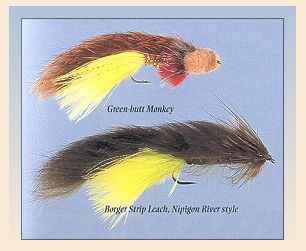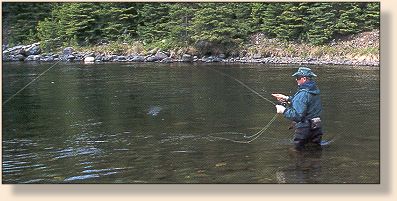Nipigon's Giant Brook Trout, Part 2
By Scott E. Smith
From Ontario, Blue-Ribbon Fly Fishing Guide, Published
by Frank Amato Publications.
We appreciate use permission.
Hatches and Flies
 I would suggest that the bulk of the large brook trout on the Nipigon
River are duped by larged streamers. By far the most successful
streamers fished by Nipigon River guides and anglers are varying
concoctions of the Strip Leech pattern developed by Gary Borger.
These rabbit-strip patterns are tied up to 3 1/2 inches long, on
3X long streamer hooks in sizes 4, 2, and even 1/0. My favourite
combination for the river is a natural-coloured beige or olive
rabbit strip with a chartreuse tail and a gold tinsel body. I
add gold Krystal Flash to the tail and a red throat, and tie
the pattern with two layers of wrapped lead. It is a formidable
looking creature for sure, but when you consider the number of
large prey items in the river, such as sculpins and crayfish, it
is logical to fish such big patterns. In addition, the needs of
any fish dictate there is no sense expending great amounts of
energy to consume what amounts to an hors d'oeuvre-sized offering,
after swimming great distances through deep, fast water. I like
the pattern I mentioned above because it works for me, but also
because I feel it accurately - or at least accurately enough - represents
sculpins and also fleeing crayfish. In addition to large sculpins,
which are the favoured diet of the Nipigon brook trout, crayfish
are very abundant along the rocky shores of the Nipigon, and when
moving about on the bottom, scoot along backwards and often
upside-down from one lie to another in the current. Brook trout
target these substantial fellows and take them quickly before they
disappear under a rock. This is also one of the reasons I like to
fish these rabbit-strip flies near the bottom with a pulsating
retrieve.
I would suggest that the bulk of the large brook trout on the Nipigon
River are duped by larged streamers. By far the most successful
streamers fished by Nipigon River guides and anglers are varying
concoctions of the Strip Leech pattern developed by Gary Borger.
These rabbit-strip patterns are tied up to 3 1/2 inches long, on
3X long streamer hooks in sizes 4, 2, and even 1/0. My favourite
combination for the river is a natural-coloured beige or olive
rabbit strip with a chartreuse tail and a gold tinsel body. I
add gold Krystal Flash to the tail and a red throat, and tie
the pattern with two layers of wrapped lead. It is a formidable
looking creature for sure, but when you consider the number of
large prey items in the river, such as sculpins and crayfish, it
is logical to fish such big patterns. In addition, the needs of
any fish dictate there is no sense expending great amounts of
energy to consume what amounts to an hors d'oeuvre-sized offering,
after swimming great distances through deep, fast water. I like
the pattern I mentioned above because it works for me, but also
because I feel it accurately - or at least accurately enough - represents
sculpins and also fleeing crayfish. In addition to large sculpins,
which are the favoured diet of the Nipigon brook trout, crayfish
are very abundant along the rocky shores of the Nipigon, and when
moving about on the bottom, scoot along backwards and often
upside-down from one lie to another in the current. Brook trout
target these substantial fellows and take them quickly before they
disappear under a rock. This is also one of the reasons I like to
fish these rabbit-strip flies near the bottom with a pulsating
retrieve.
Sometime when you're shuffling about along a rocky river-bottom,
kick up a few decent-sized stones and look for fleeing crayfish.
You will note how they swim backwards and flip upside-down in
the current as they scamper downstream to the next available
cover. This little experiement will help you understand the merits
of fishing these big flies in such a fasion near the bottom.
Although wool-head sculpin patterns, such as my Green-Butt Monkey . . .
fish well on the Nipigon, I find that often their bulky heads hamper
my attempts to get the fly deep as quickly as possible.
In addition to the rabbit-strip family of flies for the Nipigon,
the ubiquitous Woolly Bugger works equally well in the river.
Nipigon-Buggers should be tied very large, size 4 and 2, and
heavily weighted. Black and brown are the best colours as there
are both black and brown phases of large sculpins - or cockatouches
as they are locally know - in the river.
Specifically, there are two large sculpin species prevalent in the
Nipigon River: the mottled sculpin (Cottus beirdi),
and the slimy sculpin (Cottus cognatus). Both of
these species, which are almost identical in appearance, average
three inches in length, but can approach five inches in length.
which speaks to the success of large streamer patterns for brook
trout on this river.

Just about any type of popular dry will work at one time or another
on the Nipigon; but I would say the bulk of your selection should
consist of caddis patterns, large mayfly patterns, and searching
patterns, such as the Royal Trude and the Stimulator. I like
fishing size 8 and 10 Yellow Stimulators on the river, because they
are easy to see and follow especially on long casts and drifts, and
also because they represent so many different potential food sources:
stoneflies, large mayflies, and terrestrials such as hoppers and
crickets, which are prevalent during late summer. Although I have
never given it a try, I'll bet a mouse pattern will work like dynamite
when fished off the edge of the many rock cliffs along the river. One
nice thing about brook trout, if they're hungry they'll eat almost
anything. One the other hand, if they're not hungry, they can be a
real pain in the ass to catch.
One of the most significant hatches of insects on the upper Nipigon
is the salmonfly (Pteronarcys dorsata), a large species
of stonefly that thrives amongt the boulders along the banks and
island of the river. They have creamy-yellow bodies with a band of
yellow or orange on their heads. These giant stoneflies are generally
two and one-half to almost three inches in length and can be often
found drying their wings on rock islands after the nymph has crawled out of
the water and fastened itself to a rock to metamorphose into a winged
insect.
One sunny afternoon in late May I pulled my boat onto a tiny island in
the river above Jessie Lake and found hundreds of Pteronarcys
crawling from under the rocks as the sun warmed the island. In addition
to the effects of the early afternoon sun, the warmth of my Coleman stove
also attracted the stoneflies adding an "extra-special" ingredient to
my chicken-stir-fry. Stoneflies gradually left the island as their
wings completely dried, however few of them made significant progress
as they were soon picked off in mid-air by cruising sea gulls.
Because of the fact that these insect hatch off rocks and not off the
water, I believe their true value to the fly angler comes when they
return to the river to lay their eggs. This is when they become significant
to the trout population. Their large size attracts even the largest
brook trout to the surface.
In addition to the Pteronarcys, other significant insects
on the river include the Hexagenia limbata, which thrives
in the silt-bottomed areas above the dams and in the lake-like portions
of the river. They appear as large (approximately two inches long)
greenish-bodied mayflies that hatch after dark in slow-moving sections
of river. Most times both duns and spinners are present on the water,
specifically just above and just below dams. Brown drakes (Ephemera
simulans) may be the most beneficial hatch as they appear at dusk and
make for some memorable dry-fly fishing. One of my favourite patterns
for both brown and gray drakes is the Usual; a simple fly constructed
solely from the hair of a snow shoe hare's rear foot. The fly has great
buoyancy properties and it floats in the surface film as a hatching
mayfly would. I have caught numberous brook trout in the twenty-inch
range during this hatch on Usuals.
Grannon caddis hatches are also very important to the Nipigon fly
anglers. Nipigon's fish seem to have a special lust for caddisflies.
They are also present in varying numbers throughout the year.
Some less-significant hatches on the river include the Yellow Sally
stonefly, and various other smaller species of stoneflies.
The best timing for prolific hatches of caddis, mayflies and
stoneflies is generally the last two weeks of June and the first
two week of July. August can prove tough fishing if the water
temperature reach above the sixty-five degree mark. Towards
the end of August however, nighttime temperatures drop significantly
and the water begins to cool once again; brook trout begin to feed
with regularity prior to their spawn in late September on the Nipigon.
As for presentations, I would say the majority of the takes I have
had on dry flies on the Nipigon River have been on the downstream
drift of the fly. I like to cast quartering upstream with a large
reach mend, and then mend heavily - to flip the fly line upstream
of the fly and the leader - as it passes perpendicular to my
position. I then allow the fly to drift drag-free downstream
ahead of the fly line and leader, at times paying out extra line to
lengthen the drift. I have hooked fish with almost the entire
fly line on the water on some of the flatter sections of river;
hence my tendency to fish larger, more visible dries on the
Nipigon. ~ Scott E. Smith
Our Man In Canada Archives
|





